Abstract
Fluorescent probes can monitor events in lymphocytes stimulated by mitogens and antigens. Early activation is associated with conformational changes in membrane macromolecules, and has been studied by measurement of fluorescence intensity or polarization of the membrane-localizing probes ANS, NPN, DPH and TMRITC. Subsequent changes in cytoplasmic macromolecules have been detected by altered fluorescence polarization of intracellular fluorescein. Altered metabolic activity in the activated lymphocyte is also revealed by fluorescent probes: the increased red fluorescence of lysosomes seen by AO staining, is attributable to altered lysosome membrane permeability. AO fluorescence has also detected early changes in the nuclear nucleoprotein complex. The later synthesis of new DNA is readily demonstrated by increased staining with the nuclear probes AO, ethidium bromide, propidium iodide, mithramycin and the Hoechst dyes. Adaptation of fluorescent probe analyses to the now rapidly developing flow microfluorimeters is providing rapid and sensitive assays of lymphocyte stimulation. Such methods will permit routine detection of lymphocyte response to particular antigens or mitogens, as well as identification of antigenic substances by their stimulation of known reactive lymphocytes. Last but not least, fluorescent probes are providing new understanding of the cellular events and regulatory mechanisms associated with lymphocyte activation.
Full text
PDF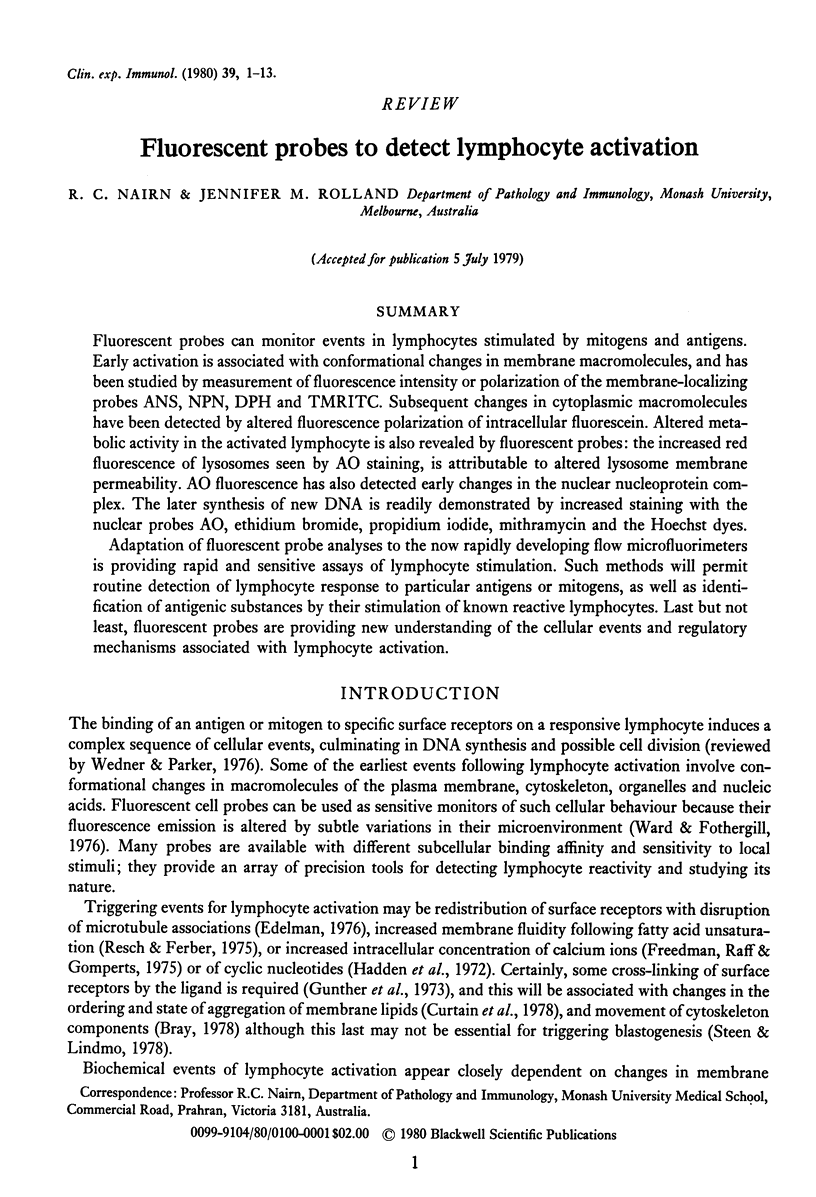
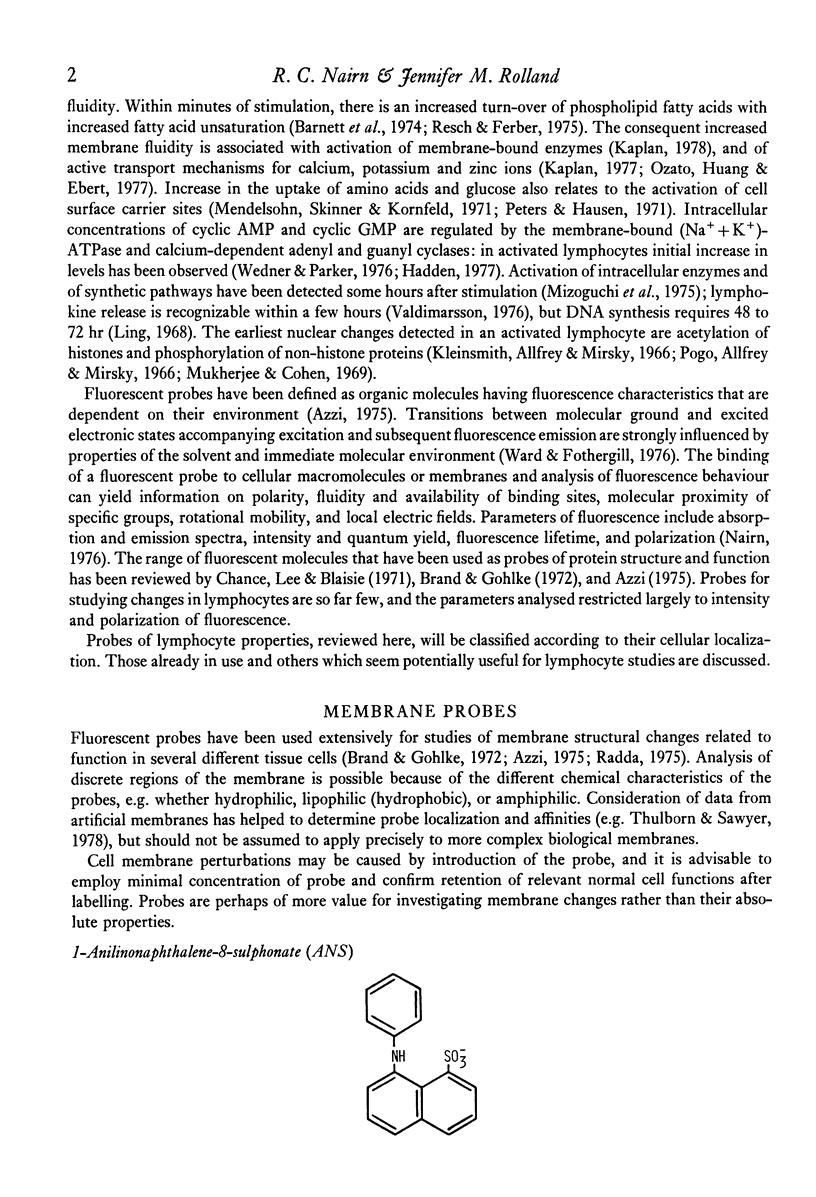
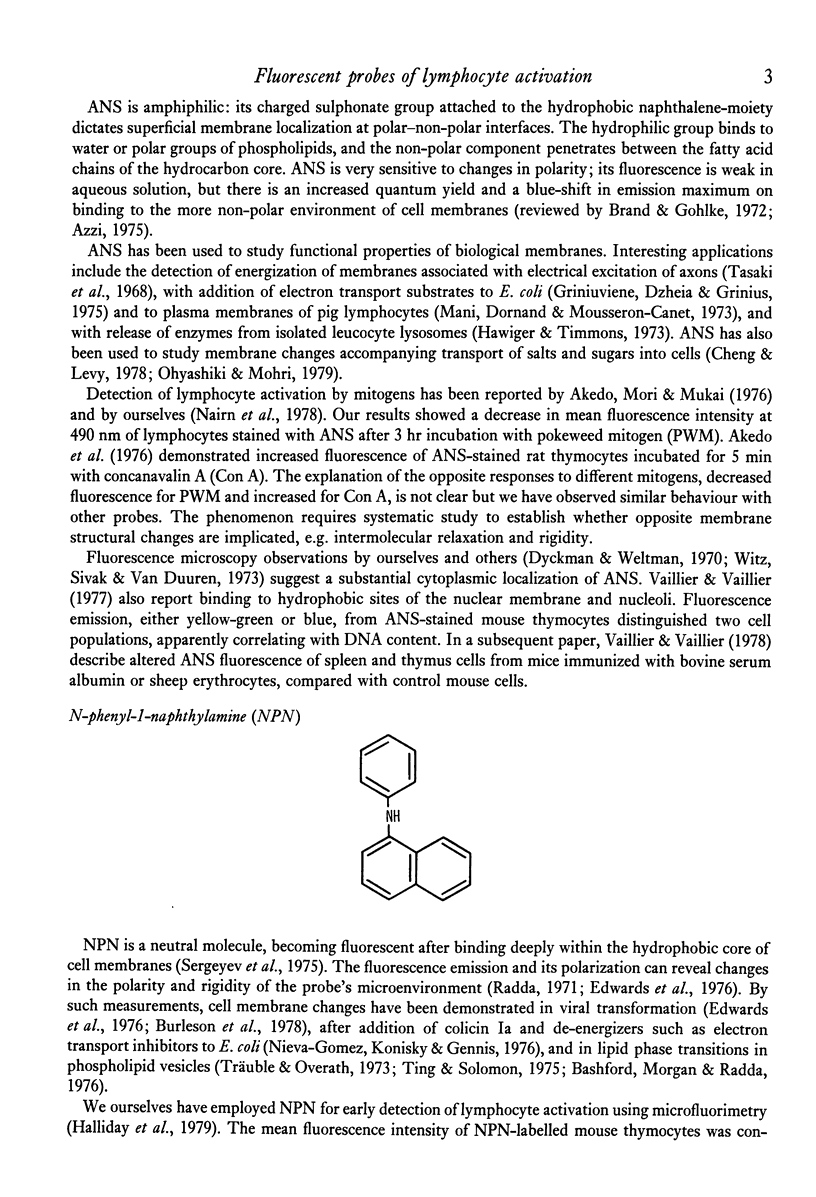
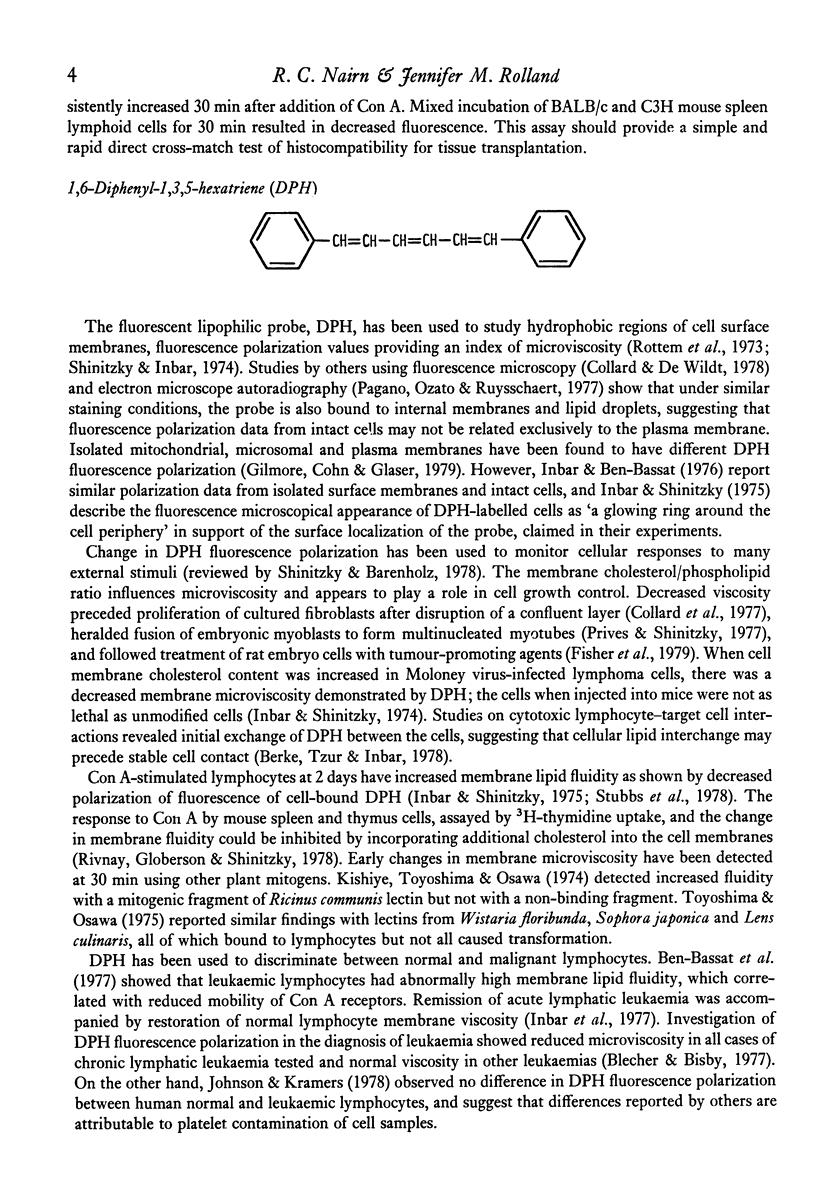
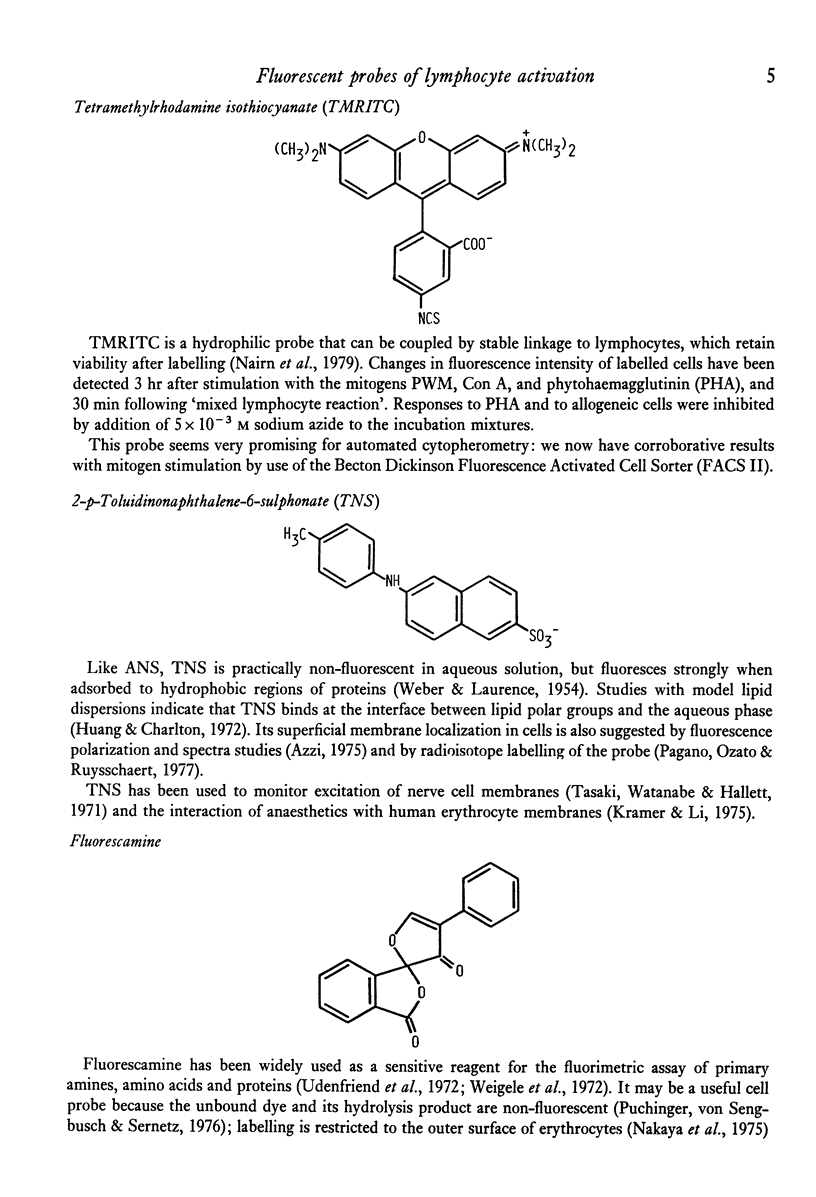
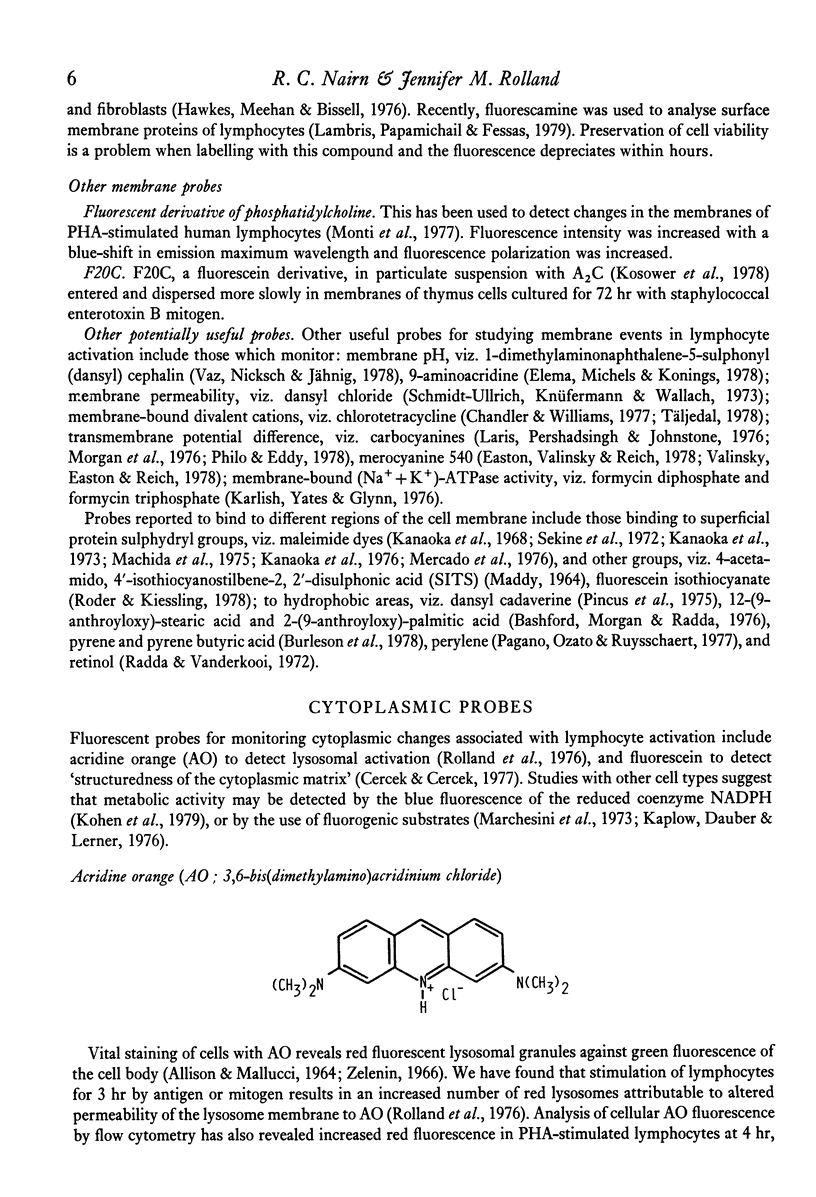
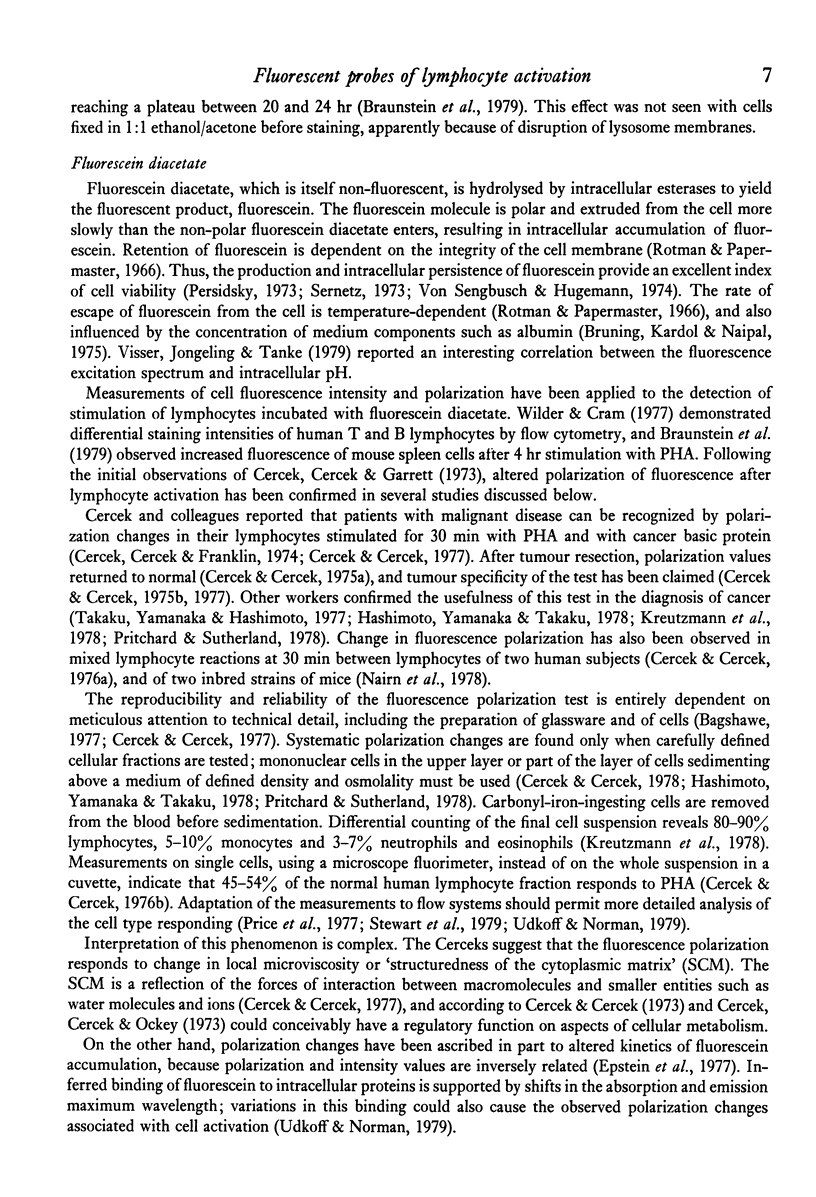
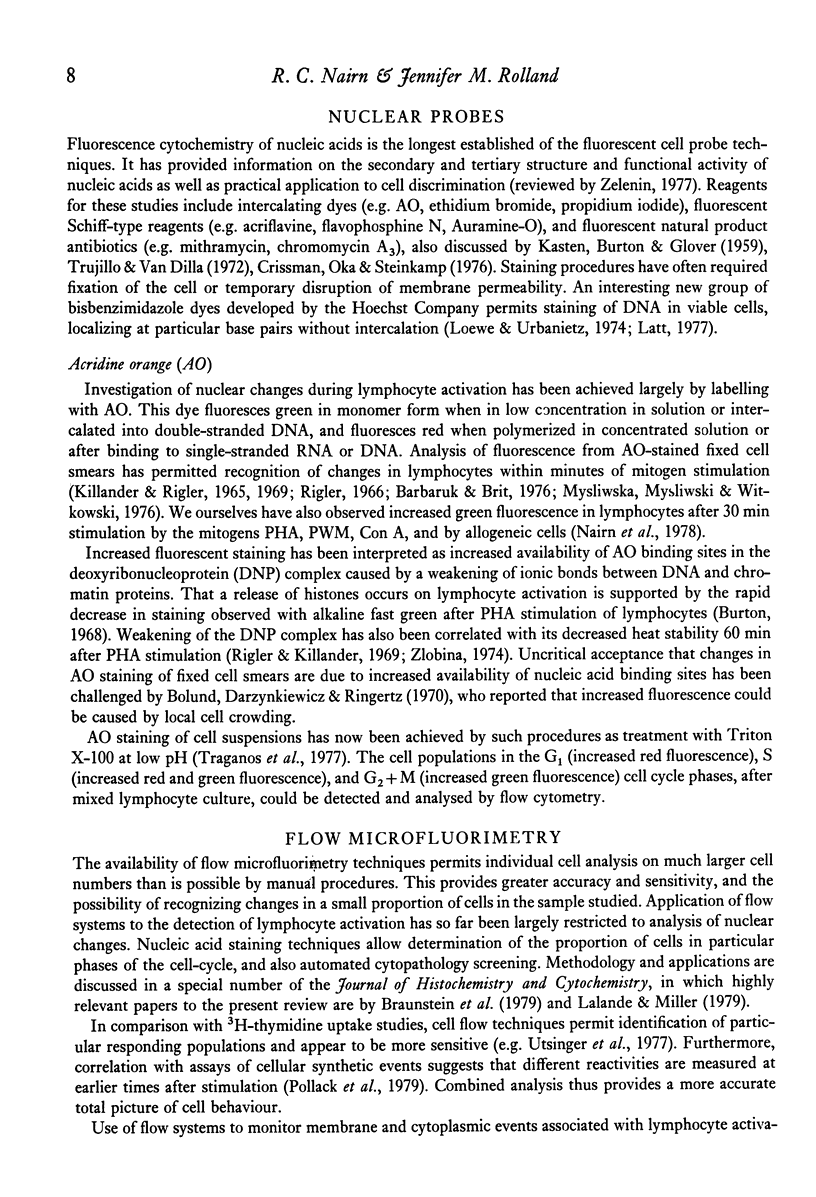
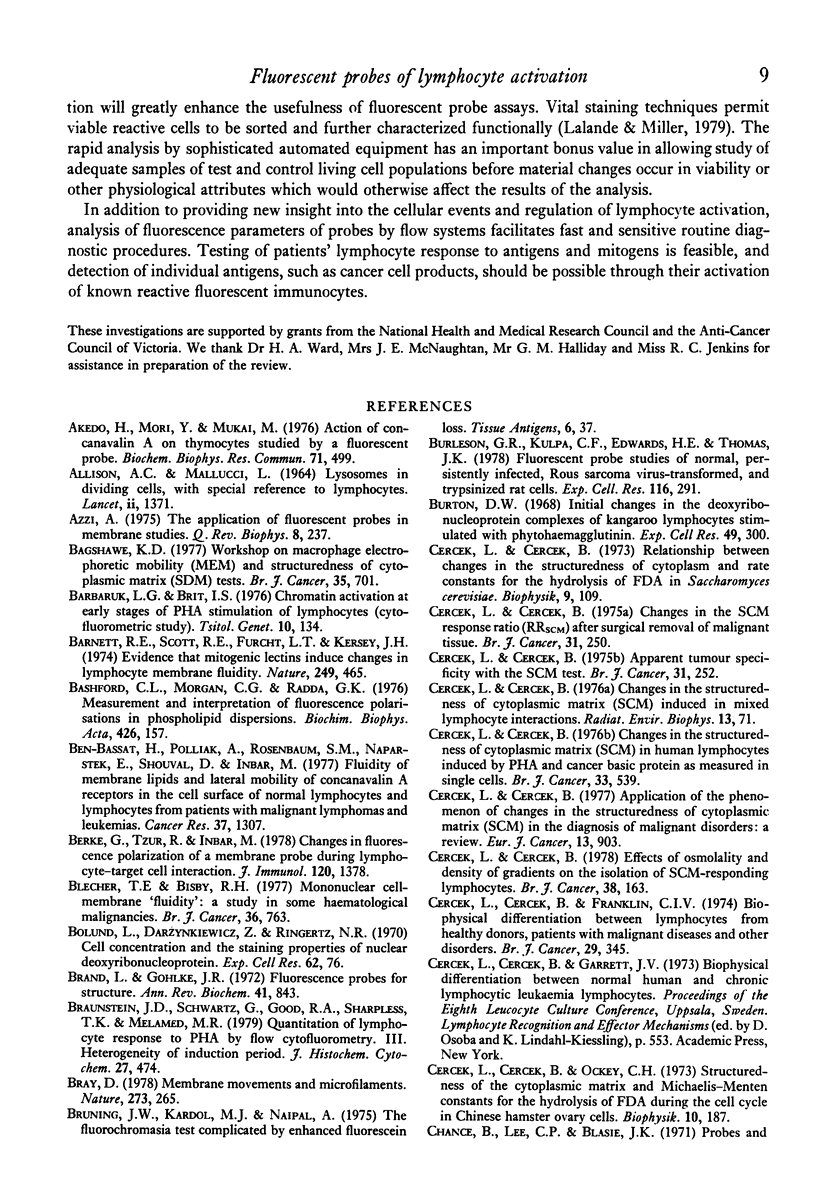
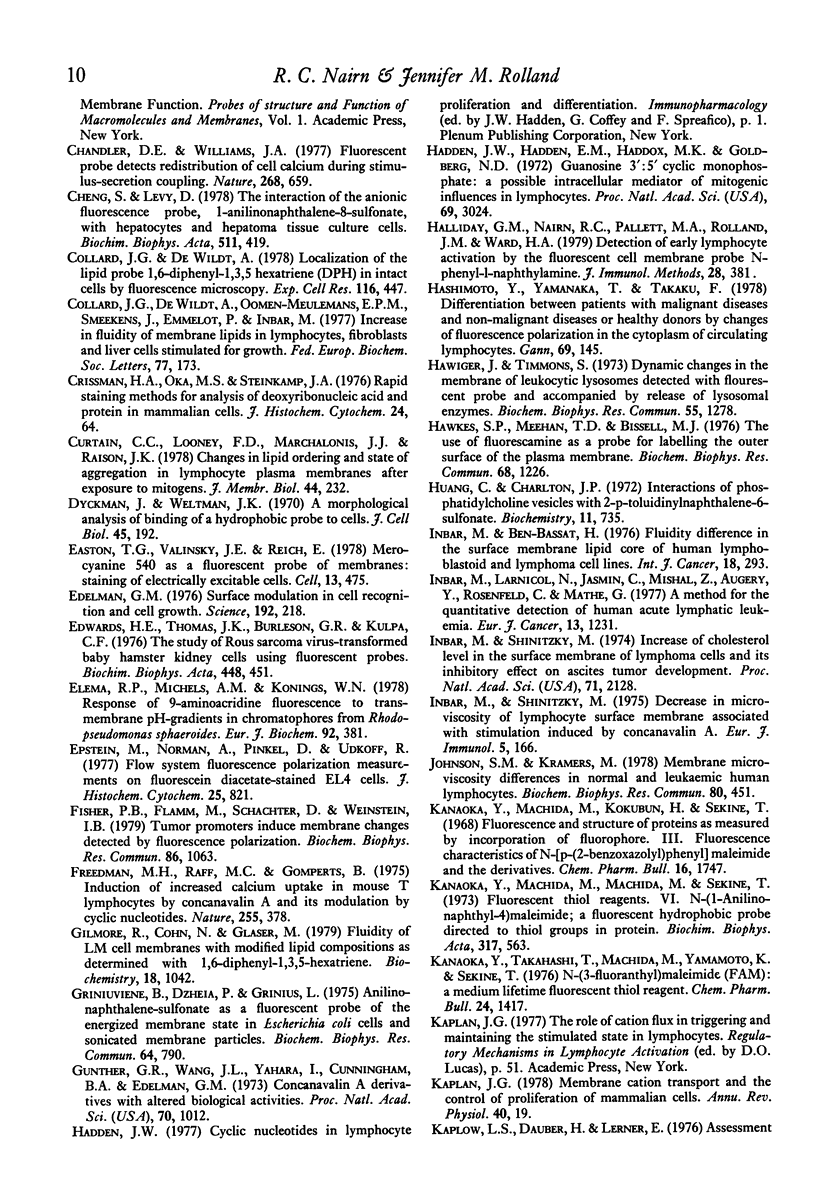
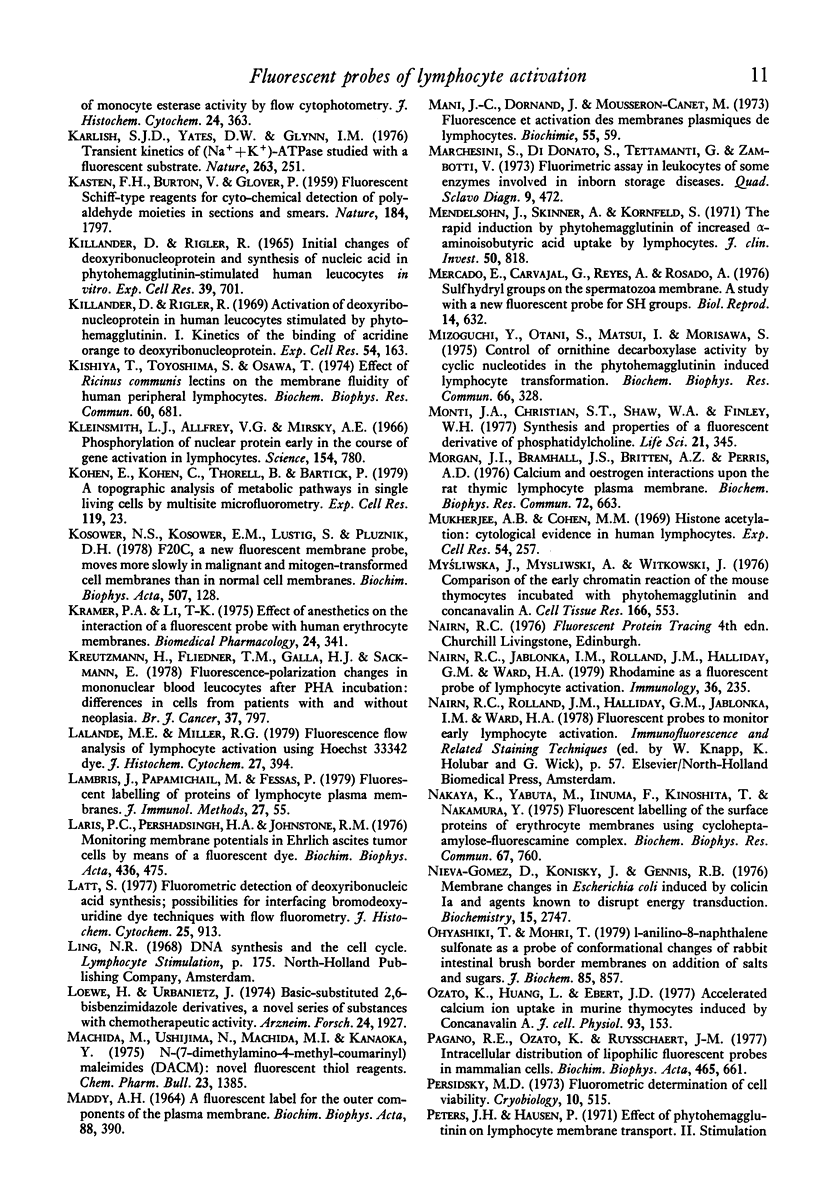
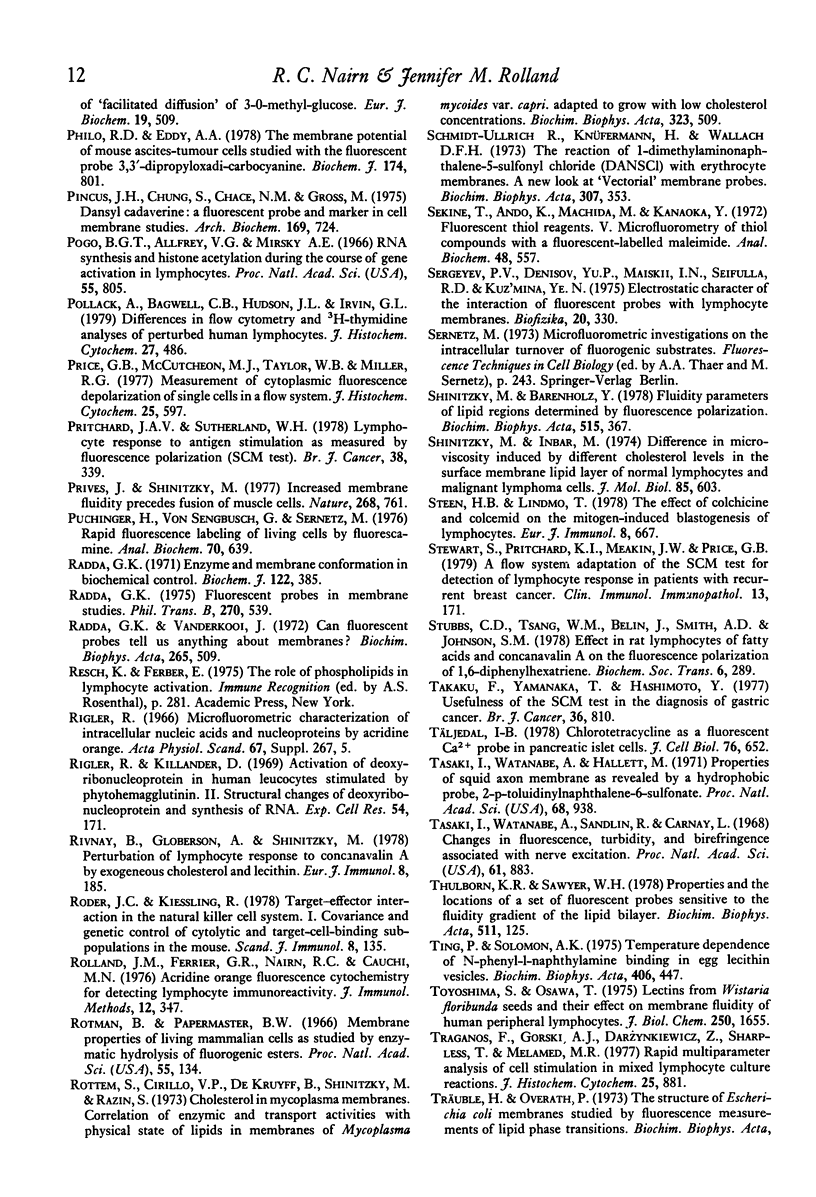
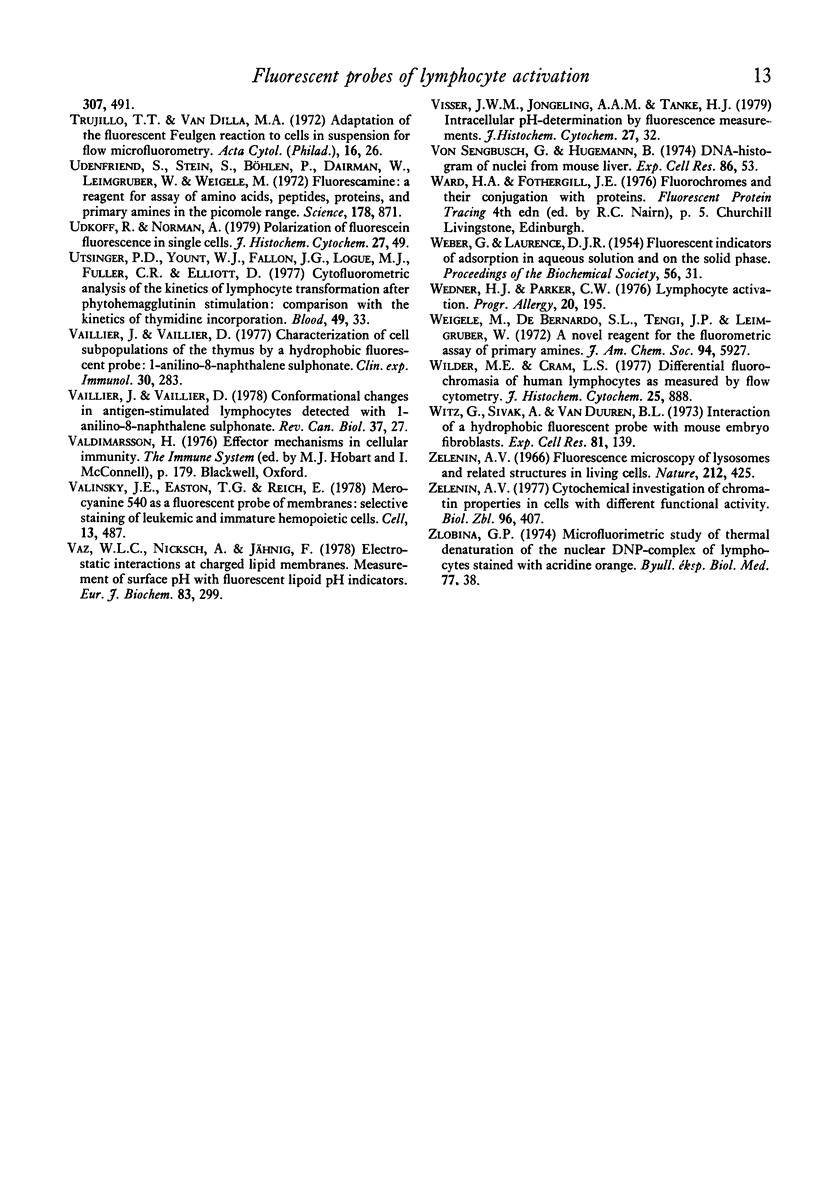
Selected References
These references are in PubMed. This may not be the complete list of references from this article.
- ALLISON A. C., MALLUCCI L. LYSOSOMES IN DIVIDING CELLS, WITH SPECIAL REFERENCE TO LYMPHOCYTES. Lancet. 1964 Dec 26;2(7374):1371–1373. doi: 10.1016/s0140-6736(64)91162-6. [DOI] [PubMed] [Google Scholar]
- Akedo H., Mori Y., Mukai M. Action of concanavalin A on thymocytes studied by a fluorescent probe. Biochem Biophys Res Commun. 1976 Jul 26;71(2):499–505. doi: 10.1016/0006-291x(76)90815-9. [DOI] [PubMed] [Google Scholar]
- Azzi A. The application of fluorescent probes in membrane studies. Q Rev Biophys. 1975 May;8(2):237–316. doi: 10.1017/s0033583500001803. [DOI] [PubMed] [Google Scholar]
- Barbaruk L. G., Brit I. S. Aktivatsiia khromatina na rannykh étapakh FGA-stimuliatsii limfotsitov (tsitofluorometrioheskoe issledovanie) Tsitol Genet. 1976 Mar-Apr;10(2):134–136. [PubMed] [Google Scholar]
- Barnett R. E., Scott R. E., Furcht L. T., Kersey J. H. Evidence that mitogenic lectins induce changes in lymphocyte membrane fluidity. Nature. 1974 May 31;249(456):465–466. doi: 10.1038/249465a0. [DOI] [PubMed] [Google Scholar]
- Bashford C. L., Morgan C. G., Radda G. K. Measurement and interpretation of fluorescence polarisations in phospholipid dispersions. Biochim Biophys Acta. 1976 Mar 5;426(2):157–172. doi: 10.1016/0005-2736(76)90329-1. [DOI] [PubMed] [Google Scholar]
- Ben-Bassat H., Polliak A., Rosenbaum S. M., Naparstek E., Shouval D., Inbar M. Fluidity of membrane lipids and lateral mobility of concanavalin A receptors in the cell surface of normal lymphocytes and lymphocytes from patients with malignant lymphomas and leukemias. Cancer Res. 1977 May;37(5):1307–1312. [PubMed] [Google Scholar]
- Berke G., Tzur R., Inbar M. Changes in fluorescence polarization of a membrane probe during lymphocyte-target cell interaction. J Immunol. 1978 Apr;120(4):1378–1384. [PubMed] [Google Scholar]
- Blecher T. E., Bisby R. H. Mononuclear cell-membrane "fluidity": a study in some haematological malignancies. Br J Cancer. 1977 Dec;36(6):763–769. doi: 10.1038/bjc.1977.259. [DOI] [PMC free article] [PubMed] [Google Scholar]
- Bolund L., Darzynkiewicz Z., Ringertz N. R. Cell concentration and the staining properties of nuclear deoxyribonucleoprotein. Exp Cell Res. 1970 Sep;62(1):76–89. doi: 10.1016/0014-4827(79)90510-x. [DOI] [PubMed] [Google Scholar]
- Brand L., Gohlke J. R. Fluorescence probes for structure. Annu Rev Biochem. 1972;41:843–868. doi: 10.1146/annurev.bi.41.070172.004211. [DOI] [PubMed] [Google Scholar]
- Braunstein J. D., Schwartz G., Good R. A., Sharpless T. K., Melamed M. R. Quantitation of lymphocyte response to PHA by flow cytofluorometry. III. Heterogeneity of induction period. J Histochem Cytochem. 1979 Jan;27(1):474–477. doi: 10.1177/27.1.86571. [DOI] [PubMed] [Google Scholar]
- Bruning J. W., Kardol M. J., Naipal A. The fluorochromasia test complicated by enhanced fluorescein loss. Tissue Antigens. 1975 Jul;6(1):37–39. doi: 10.1111/j.1399-0039.1975.tb00609.x. [DOI] [PubMed] [Google Scholar]
- Burleson G. R., Kulpa C. F., Edwards H. E., Thomas J. K. Fluorescent probe studies of normal, persistently infected, Rous sarcoma virus-transformed, and trypsinized rat cells. Exp Cell Res. 1978 Oct 15;116(2):291–300. doi: 10.1016/0014-4827(78)90451-2. [DOI] [PubMed] [Google Scholar]
- Burton D. W. Initial changes in the deoxyribonucleoprotein complexes of kangaroo lymphocytes stimulated with phytohaemagglutinin. Exp Cell Res. 1968 Feb;49(2):300–304. doi: 10.1016/0014-4827(68)90181-x. [DOI] [PubMed] [Google Scholar]
- Cercek L., Cercek B. Apparent tumour specificity with the SCM test. Br J Cancer. 1975 Feb;31(2):252–253. doi: 10.1038/bjc.1975.33. [DOI] [PMC free article] [PubMed] [Google Scholar]
- Cercek L., Cercek B. Application of the phenomenon of changes in the structuredness of cytoplasmic matrix (SCM) in the diagnosis of malignant disorders: a review. Eur J Cancer. 1977 Sep;13(9):903–915. doi: 10.1016/0014-2964(77)90166-9. [DOI] [PubMed] [Google Scholar]
- Cercek L., Cercek B. Changes in the SCM response ratio (RRscm) after surgical removal of malignant tissue. Br J Cancer. 1975 Feb;31(2):250–251. doi: 10.1038/bjc.1975.32. [DOI] [PMC free article] [PubMed] [Google Scholar]
- Cercek L., Cercek B. Changes in the structuredness of cytoplasmic matrix (SCM) in human lymphocytes induced by PHA and cancer basic protein as measured in single cells. Br J Cancer. 1976 May;33(5):539–543. doi: 10.1038/bjc.1976.85. [DOI] [PMC free article] [PubMed] [Google Scholar]
- Cercek L., Cercek B. Changes in the structuredness of cytoplasmic matrix (SCM) induced in mixed lymphocyte interactions. Radiat Environ Biophys. 1976 Mar 30;13(1):71–74. doi: 10.1007/BF01323626. [DOI] [PubMed] [Google Scholar]
- Cercek L., Cercek B. Effects of osmolality and density of gradients on the isolation of SCM-responding lymphocytes. Br J Cancer. 1978 Jul;38(1):163–165. doi: 10.1038/bjc.1978.179. [DOI] [PMC free article] [PubMed] [Google Scholar]
- Cercek L., Cercek B., Franklin C. I. Biophysical differentiation between lymphocytes from healthy donors, patients with malignant diseases and other disorders. Br J Cancer. 1974 May;29(5):345–352. doi: 10.1038/bjc.1974.81. [DOI] [PMC free article] [PubMed] [Google Scholar]
- Cercek L., Cercek B., Ockey C. H. Structuredness of the cytoplasmic matrix and Michaelis-Menten constants for the hydrolysis of FDA during the cell cycle in Chinese hamster ovary cells. Biophysik. 1973;10(3):187–194. doi: 10.1007/BF01190577. [DOI] [PubMed] [Google Scholar]
- Cercek L., Cercek B. Relationship between changes in the structuredness of cytoplasm and rate constants for the hydrolysis of FDA in Saccharomyces cerevisiae. Biophysik. 1973;9(2):109–112. doi: 10.1007/BF01215849. [DOI] [PubMed] [Google Scholar]
- Chandler D. E., Williams J. A. Fluorescent probe detects redistribution of cell calcium during stimulus-secretion coupling. Nature. 1977 Aug 18;268(5621):659–660. doi: 10.1038/268659a0. [DOI] [PubMed] [Google Scholar]
- Cheng S., Levy D. The interaction of the anionic fluorescence probe, 1-anilinonaphthalene-8-sulfonate, with hepatocytes and hepatoma tissue culture cells. Biochim Biophys Acta. 1978 Aug 17;511(3):419–429. doi: 10.1016/0005-2736(78)90278-x. [DOI] [PubMed] [Google Scholar]
- Collard J. G., De Wildt A. Localization of the lipid probe 1,6-diphenyl-1,3,5 hexatriene (DPH) in intact cells by fluorescence microscopy. Exp Cell Res. 1978 Oct 15;116(2):447–450. doi: 10.1016/0014-4827(78)90467-6. [DOI] [PubMed] [Google Scholar]
- Collard J. G., De Wildt A., Oomen-Meulemans E. P., Smeekens J., Emmelot P. Increase in fluidity of membrane lipids in lymphocytes, fibroblasts and liver cells stimulated for growth. FEBS Lett. 1977 May 15;77(2):173–178. doi: 10.1016/0014-5793(77)80228-7. [DOI] [PubMed] [Google Scholar]
- Crissman H. A., Oka M. S., Steinkamp J. A. Rapid staining methods for analysis of deoxyribonucleic acid and protein in mammalian cells. J Histochem Cytochem. 1976 Jan;24(1):64–71. doi: 10.1177/24.1.56392. [DOI] [PubMed] [Google Scholar]
- Curtain C. C., Looney F. D., Marchalonis J. J., Raison J. K. Changes in lipid ordering and state of aggregation in lymphocyte plasma membranes after exposure to mitogens. J Membr Biol. 1978 Dec 29;44(3-4):211–232. doi: 10.1007/BF01944222. [DOI] [PubMed] [Google Scholar]
- Dyckman J., Weltman J. K. A morphological analysis of binding of a hydrophobic probe to cells. J Cell Biol. 1970 Apr;45(1):192–197. doi: 10.1083/jcb.45.1.192. [DOI] [PMC free article] [PubMed] [Google Scholar]
- Easton T. G., Valinsky J. E., Reich E. Merocyanine 540 as a fluorescent probe of membranes: staining of electrically excitable cells. Cell. 1978 Mar;13(3):475–486. doi: 10.1016/0092-8674(78)90321-5. [DOI] [PubMed] [Google Scholar]
- Edelman G. M. Surface modulation in cell recognition and cell growth. Science. 1976 Apr 16;192(4236):218–226. doi: 10.1126/science.769162. [DOI] [PubMed] [Google Scholar]
- Edwards H. E., Thomas J. K., Burleson G. R., Kulpa C. F. The study of rous sarcoma virus-transformed baby hamster kidney cells using fluorescent probes. Biochim Biophys Acta. 1976 Oct 19;448(3):451–459. doi: 10.1016/0005-2736(76)90299-6. [DOI] [PubMed] [Google Scholar]
- Elema R. P., Michels P. A., Konings W. N. Response of 9-aminoacridine fluorescence to transmembrane pH-gradients in chromatophores from Rhodopseudomonas sphaeroides. Eur J Biochem. 1978 Dec;92(2):381–387. doi: 10.1111/j.1432-1033.1978.tb12757.x. [DOI] [PubMed] [Google Scholar]
- Epstein M., Norman A., Pinkel D., Udkoff R. Flow system fluorescence polarization measurements on fluorescein diacetate-stained EL4 cells. J Histochem Cytochem. 1977 Jul;25(7):821–826. doi: 10.1177/25.7.70456. [DOI] [PubMed] [Google Scholar]
- Fisher P. B., Flamm M., Schachter D., Weinstein I. B. Tumor promoters induce membrane changes detected by fluorescence polarization. Biochem Biophys Res Commun. 1979 Feb 28;86(4):1063–1068. doi: 10.1016/0006-291x(79)90225-0. [DOI] [PubMed] [Google Scholar]
- Freedman M. H., Raff M. C. Induction of increased calcium uptake in mouse T lymphocytes by concanavalin A and its modulation by cyclic nucleotides. Nature. 1975 May 29;255(5507):378–382. doi: 10.1038/255378a0. [DOI] [PubMed] [Google Scholar]
- Gilmore R., Cohn N., Glaser M. Fluidity of LM cell membranes with modified lipid compositions as determined with 1,6-diphenyl-1,3,5-hexatriene. Biochemistry. 1979 Mar 20;18(6):1042–1049. doi: 10.1021/bi00573a017. [DOI] [PubMed] [Google Scholar]
- Griniuviene B., Dzheia P., Grinius L. Anilinonaphthalenesulfonate as a fluorescent probe of the energized membrane state in Escherichia coli cells and sonicated membrane particles. Biochem Biophys Res Commun. 1975 May 19;64(2):790–796. doi: 10.1016/0006-291x(75)90390-3. [DOI] [PubMed] [Google Scholar]
- Gunther G. R., Wang J. L., Yahara I., Cunningham B. A., Edelman G. M. Concanavalin A derivatives with altered biological activities. Proc Natl Acad Sci U S A. 1973 Apr;70(4):1012–1016. doi: 10.1073/pnas.70.4.1012. [DOI] [PMC free article] [PubMed] [Google Scholar]
- Hadden J. W., Hadden E. M., Haddox M. K., Goldberg N. D. Guanosine 3':5'-cyclic monophosphate: a possible intracellular mediator of mitogenic influences in lymphocytes. Proc Natl Acad Sci U S A. 1972 Oct;69(10):3024–3027. doi: 10.1073/pnas.69.10.3024. [DOI] [PMC free article] [PubMed] [Google Scholar]
- Halliday G. M., Nairn R. C., Pallett M. A., Rolland J. M., Ward H. A. Detection of early lymphocyte activation by the fluorescent cell membrane probe N-phenyl-1-naphthylamine. J Immunol Methods. 1979;28(3-4):381–390. doi: 10.1016/0022-1759(79)90203-5. [DOI] [PubMed] [Google Scholar]
- Hashimoto Y., Yamanaka T., Takaku F. Differentiation between patients with malignant diseases and non-malignant diseases or healthy donors by changes of fluorescence polarization in the cytoplams of circulating lymphocytes. Gan. 1978 Apr;69(2):145–149. [PubMed] [Google Scholar]
- Hawiger J., Timmons S. Dynamic changes in the membrane of leukocyte lysosomes detected with fluorescent probe and accompanied by release of lysosomal enzymes. Biochem Biophys Res Commun. 1973 Dec 19;55(4):1278–1284. doi: 10.1016/s0006-291x(73)80032-4. [DOI] [PubMed] [Google Scholar]
- Hawkes S. P., Meehan T. D., Bissell M. J. The use of fluorescamine as a probe for labeling the outer surface of the plasma membrane. Biochem Biophys Res Commun. 1976 Feb 23;68(4):1226–1233. doi: 10.1016/0006-291x(76)90328-4. [DOI] [PubMed] [Google Scholar]
- Huang C. H., Charlton J. P. Interactions of phosphatidylcholine vesicles with 2-p-toluidinylnaphthalene-6-sulfonate. Biochemistry. 1972 Feb 29;11(5):735–740. doi: 10.1021/bi00755a010. [DOI] [PubMed] [Google Scholar]
- Inbar M., Ben-Bassat H. Fluidity difference in the surface membrane lipid core of human lymphoblastoid and lymphoma cell lines. Int J Cancer. 1976 Sep 15;18(3):293–297. doi: 10.1002/ijc.2910180305. [DOI] [PubMed] [Google Scholar]
- Inbar M., Larnicol N., Jasmin C., Mishal Z., Augery Y., Rosenfeld C., Mathé G. A method for the quantitative detection of human acute lymphatic leukemia. Eur J Cancer. 1977 Nov;13(11):1231–1236. doi: 10.1016/0014-2964(77)90029-9. [DOI] [PubMed] [Google Scholar]
- Inbar M., Shinitzky M. Decrease in microviscosity of lymphocyte surface membrane associated with stimulation induced by concanavalin A. Eur J Immunol. 1975 Mar;5(3):166–170. doi: 10.1002/eji.1830050303. [DOI] [PubMed] [Google Scholar]
- Inbar M., Shinitzky M. Increase of cholesterol level in the surface membrane of lymphoma cells and its inhibitory effect on ascites tumor development. Proc Natl Acad Sci U S A. 1974 May;71(5):2128–2130. doi: 10.1073/pnas.71.5.2128. [DOI] [PMC free article] [PubMed] [Google Scholar]
- Johnson S. M., Kramers M. Membrane microviscosity differences in normal and leukaemic human lymphocytes. Biochem Biophys Res Commun. 1978 Jan 30;80(2):451–457. doi: 10.1016/0006-291x(78)90698-8. [DOI] [PubMed] [Google Scholar]
- KASTEN F. H., BURTON V., GLOVER P. Fluorescent Schifftype reagents for cytochemical detection of polyaldehyde moieties in sections and smears. Nature. 1959 Dec 5;184(Suppl 23):1797–1798. doi: 10.1038/1841797a0. [DOI] [PubMed] [Google Scholar]
- Kaplan J. G. Membrane cation transport and the control of proliferation of mammalian cells. Annu Rev Physiol. 1978;40:19–41. doi: 10.1146/annurev.ph.40.030178.000315. [DOI] [PubMed] [Google Scholar]
- Kaplow L. S., Dauber H., Lerner E. Assessment of monocyte esterase activity by flow cytophotometry. J Histochem Cytochem. 1976 Jan;24(1):363–372. doi: 10.1177/24.1.1254930. [DOI] [PubMed] [Google Scholar]
- Karlish S. J., Yates D. W., Glynn I. M. Transient kinetics of (Na+ +K+)-ATPase studied with a fluorescent substrate. Nature. 1976 Sep 16;263(5574):251–253. doi: 10.1038/263251a0. [DOI] [PubMed] [Google Scholar]
- Killander D., Rigler R. Activation of deoxyribonucleoprotein in human leucocytes stimulated by phytohemagglutinin. I. Kinetics of the binding of acridine orange to deoxyribonucleoprotein. Exp Cell Res. 1969 Feb;54(2):163–170. doi: 10.1016/0014-4827(69)90228-6. [DOI] [PubMed] [Google Scholar]
- Killander D., Rigler R., Jr Initial changes of deoxyribonucleoprotein and synthesis of nucleic acid in phytohemagglutinine-stimulated human leucocytes in vitro. Exp Cell Res. 1965 Sep;39(2):701–704. doi: 10.1016/0014-4827(65)90075-3. [DOI] [PubMed] [Google Scholar]
- Kishiye T., Toyoshima S., Osawa T. Effect of Richinus communis lectins on the membrane fluidity of human peripheral lymphocytes. Biochem Biophys Res Commun. 1974 Sep 23;60(2):681–686. doi: 10.1016/0006-291x(74)90294-0. [DOI] [PubMed] [Google Scholar]
- Kleinsmith L. J., Allfrey V. G., Mirsky A. E. Phosphorylation of nuclear protein early in the course of gene activation in lymphocytes. Science. 1966 Nov 11;154(3750):780–781. doi: 10.1126/science.154.3750.780. [DOI] [PubMed] [Google Scholar]
- Kohen E., Kohen C., Thorell B., Bartick P. A topographic analysis of metabolic pathways in single living cells by multisite microfluorometry. Exp Cell Res. 1979 Mar 1;119(1):23–30. doi: 10.1016/0014-4827(79)90331-8. [DOI] [PubMed] [Google Scholar]
- Kosower N. S., Kosower E. M., Lustig S., Pluznik D. H. F20C, a new fluorescent membrane probe, moves more slowly in malignant and mitogen-transformed cell membranes than in normal cell membranes. Biochim Biophys Acta. 1978 Feb 2;507(1):128–136. doi: 10.1016/0005-2736(78)90380-2. [DOI] [PubMed] [Google Scholar]
- Kramer P. A., Li T. K. Effect of anesthetics on the interaction of a fluorescent probe with human erythrocyte membranes. Biochem Pharmacol. 1975 Feb 1;24(3):341–346. doi: 10.1016/0006-2952(75)90215-4. [DOI] [PubMed] [Google Scholar]
- Lalande M. E., Miller R. G. Fluorescence flow analysis of lymphocyte activation using Hoechst 33342 dye. J Histochem Cytochem. 1979 Jan;27(1):394–397. doi: 10.1177/27.1.86569. [DOI] [PubMed] [Google Scholar]
- Lambris J., Papamichail M., Fessas P. Fluorescent labelling of proteins of lymphocyte plasma membranes. J Immunol Methods. 1979 May 10;27(1):55–59. doi: 10.1016/0022-1759(79)90238-2. [DOI] [PubMed] [Google Scholar]
- Laris P. C., Pershadsingh H. A., Johnstone R. M. Monitoring membrane potentials in Ehrlich ascites tumor cells by means of a fluorescent dye. Biochim Biophys Acta. 1976 Jun 17;436(2):475–488. doi: 10.1016/0005-2736(76)90209-1. [DOI] [PubMed] [Google Scholar]
- Latt S. A. Fluorometric detection of deoxyribonucleic acid synthesis; possibilities for interfacing bromodeoxyuridine dye techniques with flow fluorometry. J Histochem Cytochem. 1977 Jul;25(7):913–926. doi: 10.1177/25.7.70459. [DOI] [PubMed] [Google Scholar]
- Loewe H., Urbanietz J. Basisch substituierte 2,6-Bis-benzimidazolderivate, eine neue chemotherapeutisch aktive Körperklasse. Arzneimittelforschung. 1974 Dec;24(12):1927–1933. [PubMed] [Google Scholar]
- MADDY A. H. A FLUORESCENT LABEL FOR THE OUTER COMPONENTS OF THE PLASMA MEMBRANE. Biochim Biophys Acta. 1964 Sep 25;88:390–399. doi: 10.1016/0926-6577(64)90194-9. [DOI] [PubMed] [Google Scholar]
- Mani J. C., Dornand J., Mousseron-Canet M. Fluorescence et activation des membranes plasmiques de lymphocytes. Biochimie. 1973;55(1):59–62. doi: 10.1016/s0300-9084(73)80237-8. [DOI] [PubMed] [Google Scholar]
- Marchesini S., Di Donato S., Tettamanti G., Zambotti V. Dosaggio fluorimetrico nei leucociti di alcuni enzimi implicati nelle malattie da accumulo. Quad Sclavo Diagn. 1973 Mar;9(1):472–483. [PubMed] [Google Scholar]
- Mendelsohn J., Skinner A., Kornfeld S. The rapid induction by phytohemagglutinin of increased alpha-aminoisobutyric acid uptake by lymphocytes. J Clin Invest. 1971 Apr;50(4):818–826. doi: 10.1172/JCI106553. [DOI] [PMC free article] [PubMed] [Google Scholar]
- Mercado E., Carvajal G., Reyes A., Rosado A. Sulfhydryl groups on the spermatozoa membrane. A study with a new fluorescent probe for SH groups. Biol Reprod. 1976 Jun;14(5):632–640. doi: 10.1095/biolreprod14.5.632. [DOI] [PubMed] [Google Scholar]
- Mizoguchi Y., Otani S., Matsui I., Morisawa S. Control of ornithine decarboxylase activity by cyclic nucleotides in the phytohemagglutinin induced lymphocyte transformation. Biochem Biophys Res Commun. 1975 Sep 2;66(1):328–335. doi: 10.1016/s0006-291x(75)80332-9. [DOI] [PubMed] [Google Scholar]
- Monti J. A., Christian S. T., Shaw W. A., Finley W. H. Synthesis and properties of a fluorescent derivative of phosphatidylcholine. Life Sci. 1977 Aug 1;21(3):345–355. doi: 10.1016/0024-3205(77)90515-x. [DOI] [PubMed] [Google Scholar]
- Morgan J. I., Bramhall J. S., Britten A. Z., Perris A. D. Calcium and oestrogen interactions upon the rat thymic lymphocyte plasma membrane. Biochem Biophys Res Commun. 1976 Sep 20;72(2):663–672. doi: 10.1016/s0006-291x(76)80091-5. [DOI] [PubMed] [Google Scholar]
- Mukherjee A. B., Cohen M. M. Histone acetylation: cytological evidence in human lymphocytes. Exp Cell Res. 1969 Feb;54(2):257–260. doi: 10.1016/0014-4827(69)90245-6. [DOI] [PubMed] [Google Scholar]
- Myśliwska J., Myśliwski A., Witkowski J. Comparison of the early chromatin reaction of the mouse thymocytes incubated with phytohemagglutinin and concanavalin A. Cell Tissue Res. 1976 Feb 27;166(4):553–561. doi: 10.1007/BF00225919. [DOI] [PubMed] [Google Scholar]
- Nairn R. C., Jablonka I. M., Rolland J. M., Halliday G. M., Ward H. A. Rhodamine as a fluorescent probe of lymphocyte activation. Immunology. 1979 Feb;36(2):235–240. [PMC free article] [PubMed] [Google Scholar]
- Nakaya K., Yabuta M., Iinuma F., Kinoshita T., Nakamura Y. Fluorescent labeling of the surface proteins of erythrocyte membranes using cycloheptaamylose-fluorescamine complex. Biochem Biophys Res Commun. 1975 Nov 17;67(2):760–766. doi: 10.1016/0006-291x(75)90878-5. [DOI] [PubMed] [Google Scholar]
- Nieva-Gomez D., Konisky J. Membrane changes in Escherichia coli induced by colicin Ia and agents known to disrupt energy transduction. Biochemistry. 1976 Jun 29;15(13):2747–2753. doi: 10.1021/bi00658a006. [DOI] [PubMed] [Google Scholar]
- Ohyashiki T., Mohri T. 1-Anilino-8-naphthalene sulfonate as a probe of conformational changes of rabbit intestinal brush border membranes on addition of salts and sugars. J Biochem. 1979 Mar;85(3):857–863. [PubMed] [Google Scholar]
- Ozato K., Huang L., Ebert J. D. Accelerated calcium ion uptake in murine thymocytes induced by concanavalin A. J Cell Physiol. 1977 Oct;93(1):153–160. doi: 10.1002/jcp.1040930119. [DOI] [PubMed] [Google Scholar]
- Pagano R. E., Ozato K., Ruysschaert J. M. Intracellular distribution of lipophilic fluorescent probes in mammalian cells. Biochim Biophys Acta. 1977 Mar 17;465(3):661–666. doi: 10.1016/0005-2736(77)90282-6. [DOI] [PubMed] [Google Scholar]
- Peters J. H., Hausen P. Effect of phytohemagglutinin on lymphocyte membrane transport. 2. Stimulation of "facilitated diffusion" of 3-O-methyl-glucose. Eur J Biochem. 1971 Apr 30;19(4):509–513. doi: 10.1111/j.1432-1033.1971.tb01342.x. [DOI] [PubMed] [Google Scholar]
- Philo R. D., Eddy A. A. The membrane potential of mouse ascites-tumour cells studied with the fluorescent probe 3,3'-dipropyloxadicarbocyanine. Amplitude of the depolarization caused by amino acids. Biochem J. 1978 Sep 15;174(3):801–810. doi: 10.1042/bj1740801. [DOI] [PMC free article] [PubMed] [Google Scholar]
- Pincus J. H., Chung S. I., Chace N. M., Gross M. Dansyl cadaverine: a fluorescent probe and marker in cell membrane studies. Arch Biochem Biophys. 1975 Aug;169(2):724–730. doi: 10.1016/0003-9861(75)90217-9. [DOI] [PubMed] [Google Scholar]
- Pogo B. G., Allfrey V. G., Mirsky A. E. RNA synthesis and histone acetylation during the course of gene activation in lymphocytes. Proc Natl Acad Sci U S A. 1966 Apr;55(4):805–812. doi: 10.1073/pnas.55.4.805. [DOI] [PMC free article] [PubMed] [Google Scholar]
- Pollack A., Bagwell C. B., Hudson J. L., Irvin G. L., 3rd Differences in flow cytometry and 3H-thymidine analyses of perturbed human lymphocytes. J Histochem Cytochem. 1979 Jan;27(1):486–490. doi: 10.1177/27.1.220326. [DOI] [PubMed] [Google Scholar]
- Price G. B., McCutcheon M. J., Taylor W. B., Miller R. G. Measurement of cytoplasmic fluorescence depolarization of single cells in a flow system. J Histochem Cytochem. 1977 Jul;25(7):597–600. doi: 10.1177/25.7.302266. [DOI] [PubMed] [Google Scholar]
- Pritchard J. A., Sutherland W. H. Lymphocyte response to antigen stimulation as measured by fluorescence polarization (SCM test). Br J Cancer. 1978 Aug;38(2):339–343. doi: 10.1038/bjc.1978.208. [DOI] [PMC free article] [PubMed] [Google Scholar]
- Prives J., Shinitzky M. Increased membrane fluidity precedes fusion of muscle cells. Nature. 1977 Aug 25;268(5622):761–763. doi: 10.1038/268761a0. [DOI] [PubMed] [Google Scholar]
- Puchinger H., von Sengbusch G., Sernetz M. Rapid fluorescence labeling of living cells by fluorescamine. Anal Biochem. 1976 Feb;70(2):639–642. doi: 10.1016/0003-2697(76)90494-2. [DOI] [PubMed] [Google Scholar]
- Radda G. K. Enzyme and membrane conformation in biochemical control. Biochem J. 1971 May;122(4):385–396. doi: 10.1042/bj1220385. [DOI] [PMC free article] [PubMed] [Google Scholar]
- Radda G. K. Fluorescent probes in membrane studies. Philos Trans R Soc Lond B Biol Sci. 1975 Jun 10;270(908):539–549. doi: 10.1098/rstb.1975.0030. [DOI] [PubMed] [Google Scholar]
- Rigler R., Killander D. Activation of deoxyribonucleoprotein in human leucocytes stimulated by phytohemagglutinin. II. Structural changes of deoxyribonucleoprotein and synthesis of RNA. Exp Cell Res. 1969 Feb;54(2):171–180. doi: 10.1016/0014-4827(69)90229-8. [DOI] [PubMed] [Google Scholar]
- Rivnay B., Globerson A., Shinitzky M. Peturbation of lymphocyte response to concanavalin A by exogenous cholesterol and lecithin. Eur J Immunol. 1978 Mar;8(3):185–189. doi: 10.1002/eji.1830080309. [DOI] [PubMed] [Google Scholar]
- Roder J. C., Kiessling R. Target--effector interaction in the natural killer cell system. I. Covariance and genetic control of cytolytic and target-cell-binding subpopulations in the mouse. Scand J Immunol. 1978;8(2):135–144. doi: 10.1111/j.1365-3083.1978.tb00505.x. [DOI] [PubMed] [Google Scholar]
- Rolland J. M., Ferrier G. R., Nairn R. C., Cauchi M. N. Acridine orange fluorescence cytochemistry for detecting lymphocyte immunoreactivity. J Immunol Methods. 1976;12(3-4):347–354. doi: 10.1016/0022-1759(76)90056-9. [DOI] [PubMed] [Google Scholar]
- Rotman B., Papermaster B. W. Membrane properties of living mammalian cells as studied by enzymatic hydrolysis of fluorogenic esters. Proc Natl Acad Sci U S A. 1966 Jan;55(1):134–141. doi: 10.1073/pnas.55.1.134. [DOI] [PMC free article] [PubMed] [Google Scholar]
- Rottem S., Cirillo V. P., de Kruyff B., Shinitzky M., Razin S. Cholesterol in mycoplasma membranes. Correlation of enzymic and transport activities with physical state of lipids in membranes of Mycoplasma mycoides var. capri adapted to grow with low cholesterol concentrations. Biochim Biophys Acta. 1973 Nov 16;323(4):509–519. doi: 10.1016/0005-2736(73)90159-4. [DOI] [PubMed] [Google Scholar]
- Schmidt-Ullrich R., Knüfermann H., Wallach D. F. The reaction of 1-dimethylaminonaphthalene-5-sulfonyl chloride (DANSC1) with erythrocyte membranes. A new look at "vectorial" membrane probes. Biochim Biophys Acta. 1973 May 11;307(2):353–365. doi: 10.1016/0005-2736(73)90101-6. [DOI] [PubMed] [Google Scholar]
- Sekine T., Ando K., Machida M., Kanaoka Y. Fluorescent thiol reagents. V. Microfluorometry of thiol compounds with a fluorescent-labeled maleimide. Anal Biochem. 1972 Aug;48(2):557–568. doi: 10.1016/0003-2697(72)90111-x. [DOI] [PubMed] [Google Scholar]
- Sergeev P. V., Denisov Iu P., Maiskii I. N., Seifulla R. D., Kuz'mina E. N. Elektristaticheskii kharakter vzaimodeistviia fluorestsentnykh zondov s membranami limfotsitov. Biofizika. 1975 Mar-Apr;20(2):330–332. [PubMed] [Google Scholar]
- Shinitzky M., Barenholz Y. Fluidity parameters of lipid regions determined by fluorescence polarization. Biochim Biophys Acta. 1978 Dec 15;515(4):367–394. doi: 10.1016/0304-4157(78)90010-2. [DOI] [PubMed] [Google Scholar]
- Shinitzky M., Inbar M. Difference in microviscosity induced by different cholesterol levels in the surface membrane lipid layer of normal lymphocytes and malignant lymphoma cells. J Mol Biol. 1974 Jan 5;85(4):603–615. doi: 10.1016/0022-2836(74)90318-0. [DOI] [PubMed] [Google Scholar]
- Steen H. B., Lindmo T. The effect of colchicine and colcemid on the mitogen-induced blastogenesis of lymphocytes. Eur J Immunol. 1978 Sep;8(9):667–671. doi: 10.1002/eji.1830080912. [DOI] [PubMed] [Google Scholar]
- Stewart S., Pritchard K. I., Meakin J. W., Price G. B. A flow system adaptation of the SCM test for detection of lymphocyte response in patients with recurrent breast cancer. Clin Immunol Immunopathol. 1979 Jun;13(2):171–181. doi: 10.1016/0090-1229(79)90061-8. [DOI] [PubMed] [Google Scholar]
- Stubbs C. D., Tsang W. M., Belin J., Smith A. D., Johnson S. M. Effect in rat lymphocytes of fatty acids and concanavalin A on the fluorescence polarization of 1,6-diphenylhexatriene [proceedings]. Biochem Soc Trans. 1978;6(1):289–290. doi: 10.1042/bst0060289. [DOI] [PubMed] [Google Scholar]
- Takaku F., Yamanaka T., Hashimoto Y. Usefulness of the SCM test in the diagnosis of gastric cancer. Br J Cancer. 1977 Dec;36(6):810–813. doi: 10.1038/bjc.1977.266. [DOI] [PMC free article] [PubMed] [Google Scholar]
- Tasaki I., Watanabe A., Hallett M. Properties of squid axon membrane as revealed by a hydrophobic probe, 2-p-toluidinylnaphthalene-6-sulfonate. Proc Natl Acad Sci U S A. 1971 May;68(5):938–941. doi: 10.1073/pnas.68.5.938. [DOI] [PMC free article] [PubMed] [Google Scholar]
- Tasaki I., Watanabe A., Sandlin R., Carnay L. Changes in fluorescence, turbidity, and birefringence associated with nerve excitation. Proc Natl Acad Sci U S A. 1968 Nov;61(3):883–888. doi: 10.1073/pnas.61.3.883. [DOI] [PMC free article] [PubMed] [Google Scholar]
- Thulborn K. R., Sawyer W. H. Properties and the locations of a set of fluorescent probes sensitive to the fluidity gradient of the lipid bilayer. Biochim Biophys Acta. 1978 Aug 4;511(2):125–140. doi: 10.1016/0005-2736(78)90308-5. [DOI] [PubMed] [Google Scholar]
- Ting P., Solomon A. K. Temperature dependence of N-phenyl-1-naphthylamine binding in egg lecithin vesicles. Biochim Biophys Acta. 1975 Oct 17;406(3):447–451. doi: 10.1016/0005-2736(75)90023-1. [DOI] [PubMed] [Google Scholar]
- Toyoshima S., Osawa T. Lectins from Wistaria floribunda seeds and their effect on membrane fluidity of human peripheral lymphocytes. J Biol Chem. 1975 Mar 10;250(5):1655–1660. [PubMed] [Google Scholar]
- Traganos F., Gorski A. J., Darzynkiewicz Z., Sharpless T., Melamed M. R. Rapid multiparameter analysis of cell stimulation in mixed lymphocyte culture reactions. J Histochem Cytochem. 1977 Jul;25(7):881–887. doi: 10.1177/25.7.142787. [DOI] [PubMed] [Google Scholar]
- Trujillo T. T., Van Dilla M. A. Adaptation of the fluorescent Feulgen reaction to cells in suspension for flow microfluorometry. Acta Cytol. 1972 Jan-Feb;16(1):26–30. [PubMed] [Google Scholar]
- Täljedal I. B. Chlorotetracycline as a fluorescent Ca2+ probe in pancreatic islet cells. J Cell Biol. 1978 Mar;76(3):652–674. doi: 10.1083/jcb.76.3.652. [DOI] [PMC free article] [PubMed] [Google Scholar]
- Udenfriend S., Stein S., Böhlen P., Dairman W., Leimgruber W., Weigele M. Fluorescamine: a reagent for assay of amino acids, peptides, proteins, and primary amines in the picomole range. Science. 1972 Nov 24;178(4063):871–872. doi: 10.1126/science.178.4063.871. [DOI] [PubMed] [Google Scholar]
- Udkoff R., Norman A. Polarization of fluorescein fluorescence in single cells. J Histochem Cytochem. 1979 Jan;27(1):49–55. doi: 10.1177/27.1.438505. [DOI] [PubMed] [Google Scholar]
- Utsinger P. D., Yount W. J., Fallon J. G., Logue M. J., Fuller C. R., Elliott D. Cytofluorometric analysis of the kinetics of lymphocyte transformation after phytohemagglutinin stimulation: comparison with the kinetics of thymidine incorporation. Blood. 1977 Jan;49(1):33–46. [PubMed] [Google Scholar]
- Vaillier J., Vaillier D. Characterization of cell subpopulations of the thymus by a hydrophobic fluorescent probe: 1-anilino-8-naphthalene sulphonate. Clin Exp Immunol. 1977 Nov;30(2):283–288. [PMC free article] [PubMed] [Google Scholar]
- Vaillier J., Vaillier D. Conformational changes in antigen-stimulated lymphocytes detected with 1-anilino-8-naphthalene sulphonate. Rev Can Biol. 1978 Mar;37(1):27–34. [PubMed] [Google Scholar]
- Valinsky J. E., Easton T. G., Reich E. Merocyanine 540 as a fluorescent probe of membranes: selective staining of leukemic and immature hemopoietic cells. Cell. 1978 Mar;13(3):487–499. doi: 10.1016/0092-8674(78)90322-7. [DOI] [PubMed] [Google Scholar]
- Vaz W. L., Nisksch A., Jähnig F. Electrostatic interactions at charged lipid membranes. Measurement of surface pH with fluorescent lipoid pH indicators. Eur J Biochem. 1978 Feb 1;83(1):299–305. doi: 10.1111/j.1432-1033.1978.tb12094.x. [DOI] [PubMed] [Google Scholar]
- Visser J. W., Jongeling A. A., Tanke H. J. Intracellular pH-determination by fluorescence measurements. J Histochem Cytochem. 1979 Jan;27(1):32–35. doi: 10.1177/27.1.35567. [DOI] [PubMed] [Google Scholar]
- Wedner H. J., Parker C. W. Lymphocyte activation. Prog Allergy. 1976;20:195–300. [PubMed] [Google Scholar]
- Wilder M. E., Cram L. S. Differential fluorochromasia of human lymphocytes as measured by flow cytometry. J Histochem Cytochem. 1977 Jul;25(7):888–891. doi: 10.1177/25.7.70458. [DOI] [PubMed] [Google Scholar]
- Witz G., Sivak A., van Duuren B. L. Interaction of a hydrophobic fluorescent probe with mouse embryo fibroblasts. Exp Cell Res. 1973 Sep;81(1):139–142. doi: 10.1016/0014-4827(73)90120-1. [DOI] [PubMed] [Google Scholar]
- Zelenin A. V. Fluorescence microscopy of lysosomes and related structures in living cells. Nature. 1966 Oct 22;212(5060):425–426. doi: 10.1038/212425a0. [DOI] [PubMed] [Google Scholar]
- von Sengbusch G., Hugemann B. A fluorescence microscope attachment for flow-through cytofluorometry. Exp Cell Res. 1974 May;86(1):53–58. doi: 10.1016/0014-4827(74)90646-6. [DOI] [PubMed] [Google Scholar]


